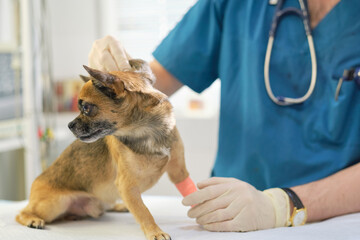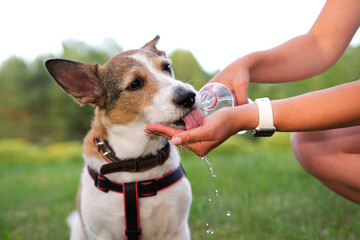
Signs of Dehydration in Dogs
Doggy dehydration occurs when the body loses more fluid than it is taking in. Your furry friend, and all mammals, rely on water to keep their body functioning correctly.
Water is essential for every body function for both you and your companion. Dehydration causes reduced blood flow, which reduces the amount of oxygen provided to organs. Additionally, it causes a loss of sodium, chloride, and potassium, which are essential for body function, such as balancing pH, providing nutrients to cells, boosting muscle function, and controlling nerve function. In more severe cases, dehydration can lead to kidney failure and death.
Causes

The most common cause of dehydration is a lack of water intake. This cause can be due to your pup not having access to enough water or just not drinking enough. Vomiting, diarrhea, heatstroke, or fever can also cause dehydration. It is essential to keep your pup hydrated and cool during hot days. Underlying conditions can also cause dehydration. For example, kidney disease, diabetes, and some types of cancer may cause dehydration in your pup. Some canines are more prone to dehydration. These canines include puppies, senior dogs, nursing mothers, and toy breeds.
Symptoms
It would be much more convenient if your companion could tell you when they are thirsty. But, knowing the signs of dehydration can help you quickly respond. Symptoms include:
- loss of skin elasticity
- loss of appetite
- vomiting
- diarrhea
- reduced energy
- lethargy
- panting
- dry eyes
- dry nose
- dry gums
- thick saliva
It is easiest to test your dog’s skin elasticity. Gently pull some of your pup’s skin near the shoulder blades and then let it go. Well-hydrated dog skin will spring back into place. If your pup is dehydrated, it will take longer to reset. You should test your dog’s skin when hydrated to have a baseline for comparison.
Also, you can check your four-legged friend’s gums similarly. Gently press your finger on their gums and then remove it. If your pup is well-hydrated, the area will appear white for a second and then return to its typical pink. However, if your pal is dehydrated, the site will appear white for longer.
Treatment

If you presume your pup is dehydrated, make sure your canine drinks plenty of cool, fresh water. Additionally, if your dog shows any symptoms of dehydration, you should visit the vet immediately. Not only is this a medical emergency, but dehydration can also be a symptom of a more significant issue. Your vet will be able to identify and treat the underlying condition.
Prevention

The best way to prevent dehydration is to provide clean water to your furry friend constantly. Generally, your pup needs one ounce of water per pound of body weight each day. Some pups may drink more than others and need more water depending on weather, temperature, and activity level. Additionally, you should always carry water to ensure your pup has access to water. Doggy water bottles are the best method for this! To ensure your pal is drinking enough water, try flavoring the water with bone broth or giving your canine ice cubes.
Understanding the seriousness of doggy dehydration is vital in prevention. Now that you know the signs of dehydration, you can better prevent and catch it before it becomes dangerous for your furry friend.
